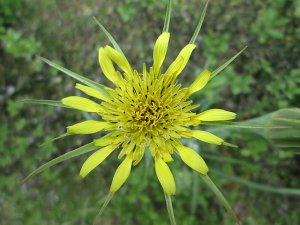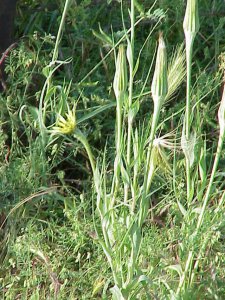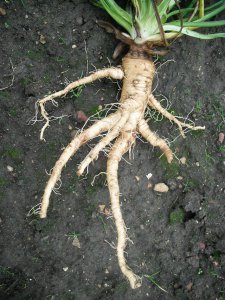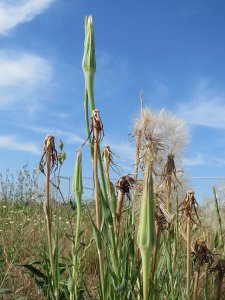Yellow salsify (Tragopogon dubius) is a yellow flowering plant that’s commonly found in most of the continental US except for the far Southeast.

Yellow salsify is a species of salsify native to southern and central Europe and western Asia and found as far north and west as northern France. Yellow salsify was introduced to North America as a garden plant in the early 1900s. Spread was likely from east to west, as this was the pattern exhibited by other salsify plants of the time.
Yellow salsify also goes by many other names including western salsify, western goat’s-beard, wild oyster plant, yellow goat’s beard, goat’s beard, goatsbeard, common salsify, and sometimes just salsify. The name oyster plant or vegetable oyster comes from the fact that it will open and close its bloom daily and people tout tasting an oyster taste when eating yellow salsify. The yellow salsify opens in early morning and closes up by late afternoon.

Yellow Salsify Edibility and Culinary Use
Yellow salsify, a skinnier relative of the parsnip, is a delicious, creamy and versatile winter vegetable. Yellow salsify is more nutritious compared to most starchy alternatives like potatoes, however, it’s just as versatile.
It belongs to the dandelion family in which people will generally make dishes from all parts of the plant, including the roots, stems, flower buds and seeds.

Yellow salsify has a thick, tuberous taproot that looks similar to orangish-yellow parsnips or carrots when peeled. The leaves are green with purple veins running through them, the stems are light green with purple stripes up them. The flowers are bright yellow and are only in bloom during the day, closing before late afternoon.

When harvested, the plant is in blossom with a yellow flower that resembles a dandelion. These flowers can be easily plucked or cut, boiled for 2-5 minutes, then served as a side dish or a healthy addition to your next omelete.
The root must be peeled before cooking because the skin is very tough. After peeling, it can be boiled, mashed, sautéed, steamed or roasted.
One cup of boiled, mashed yellow salsify contains:
Calories: 83
Fat: 0.3 g
Carbohydrates: 20.1 g
Fiber: 3.8 g
Sugar: 2.5 g
Protein: 2.3 g
Vitamin A: 5% of the Daily Value (DV)
Thiamin: 6% of the DV
Niacin: 8% of the DV
Vitamin C: 12% of the DV
Calcium: 4% of the DV
Iron: 6% of the DV
Potassium: 10% of the DV
Yellow Salsify Health Benefits
Yellow salsify is jam packed with nutrients including critical portions of iron, potassium, calcium, manganese, phosphorous, magnesium, and copper, as well as vitamins including ascorbic acid, pantothenic acid, thiamine, riboflavin, folate, and vitamin B6. Yellow salsify also has significant amounts of dietary fiber and protein
Inulin
The yellow salsify root contains a starch called inulin which some people have trouble digesting, this also makes yellow salsify popularly used on low-carb diets because of this. It’s considered safe to eat for people with celiac disease or other forms of gluten intolerance, but there are no guarantees.
Inulin also acts as a prebiotic that boosts the abundance of health-promoting bacteria in your gut and increases their activity. Prebiotics like Inulin can help diversify the biodiversity of your gut (which is a sign of gut health) and provide fuel for good bacteria to do their jobs, like making important fatty acids and vitamins.
Your gut is the biggest portion of your immune system, consuming prebiotics like inulin will help support your body’s ability to stave off infection or disease.
Improves Bone Health
Yellow salsify levels of magnesium, phosphorus, calcium, copper, iron, and manganese are key to improving bone strength. It can prevent the development of common, age-related conditions like osteoporosis and even arthritis, which can occur when bones begin to degrade and connective tissue no longer maintains the integrity of your joints.
The inulin present in yellow salsify allows your gut to digest more of those bone-building minerals. This allows the minerals to be more bioavailable in your food and leads to maximizing your mineral intake.
Yellow Salsify Cautions
When purchasing yellow salsify, make sure you are getting the vegetable and not its inulin-rich relative, the dandelion. The dandelion is an invasive weed that can take over your garden and is not as tasty. The dandelion looks very similar to yellow salsify with similar colored blooms and seed pods.
Yellow salsify secretes a milky-white substance when the stems or leaves are broken. While not poisonous, the goo is immensely difficult to remove once it dries on your clothing or skin.
When digging up yellow salsify roots, take caution not to break off the roots in the soil during harvest. Use a digging tool, a stick or your fingers to loosen up the soil around the roots before trying to pull them out.
Conclusion
So why should you know about yellow salsify? It’s an overlooked, healthy vegetable that tastes great and has many health benefits. This oyster plant is sure to add interesting flavor to your next meal, especially if you are looking for vegetarian options .
Many mistake yellow salsify for a dandelion, the big difference is in the flavor and nutrient profile. Adding yellow salsify to your next foraged meal is a great way to add a tasty starch while providing more nutrients than other starches like potatoes and bread.
————— See our privacy policy for more information about ads on this site
Written by Jared DeValk
Jared DeValk is an author, writer, and entrepreneur who in his free time can be caught hiking, planting berry bushes, or doing home repairs and improvements. Jared's varied life experience and passion for research empassions him to write knowledgeably about many topics such as , Health & Wellness, Real Estate, Finance, Business, Cryptocurrency, Home Improvement, Agriculture, Camping/Hiking, and many more. Jared can be reached directly for speaking, marketing, and writing inquiries at JaredDeValk.com.
Many of our readers find that subscribing to Eat The Planet is the best way to make sure they don't miss any of our valuable information about wild edibles.







4 Responses
This plant/weed grew out of nowhere in an area that only has small ornamental rocks. There is really no where for it to spread but I suppose tge wind could carry the seeds anywhere. Would I be better off to just kill it and forget about it or should I let it live and eat it? 😊
I, too, had it randomly grow in my yard. Wondering the same as you!
The earth grows just what we need because God is super abundant. 😄 I have a ton of it growing in my yard and it is exactly the medicine I need right now. I’ve had salsify with all three meals today. Ha!
Harvest the seeds from your one stray plant. Grow them in your garden in containers or directly in the ground. Raising yellow salsify is simple and has so many benefits. Happy healthy gardening.